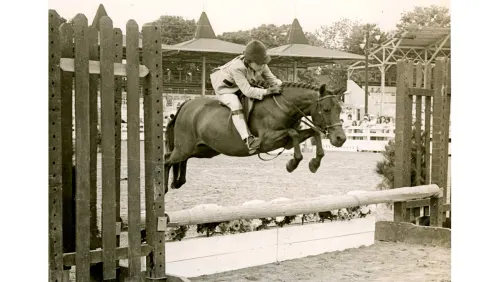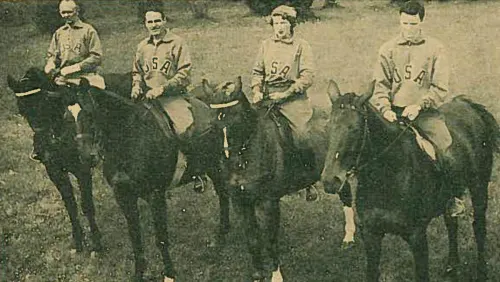Pam Rush (née Turbow) remembers being mesmerized every time she watched War Dress canter around a course.
“She was just one of those horses that loved the show ring,” Rush recalled. “She’s kind of like Rox Dene. She did her job beautifully over and over again.”
Though her father, Morton Turbow, had purchased a promising young hunter named San Felipe who was cleaning up in the professional divisions with Rodney Bross and then Rodney Jenkins and was intended to be her junior hunter, Rush wanted to ride War Dress even more.
In 1974, Turbow got a call offering his daughter the opportunity of a lifetime.
“Chief Jenkins [Rodney’s father] called my father and said, ‘I’ve got this little chestnut mare of Mrs. Randolph’s. Would your daughter want to ride it instead?’ ” Rush recalled. “My father knew the name of the horse and said yes. I never sat on the horse. He brought it home and someone said to him, ‘What do you mean she didn’t try the horse?’ ”
Turbow’s answer: “If Pam can’t win on War Dress, she needs a new way to spend her time.”
Watching Like A Hawk
Bred and owned by Theodora Randolph, War Dress was foaled in Upperville, Virginia, in 1965. Sired by The Hammer (My Babu—Dark Rose, Nearco) and out of War Garb (Benagi—War Party, Man O’ War), her bloodlines included racing royalty, but she never made it to the track. Since the mare stood just 15.2, Randolph decided to send her straight to the show ring.
War Dress started under Charlie Weaver’s saddle, competing in the green hunter and the small junior divisions in 1970 and ’71. With her gleaming copper coat, elegant head and neck, and beautiful way of going, War Dress quickly turned heads, winning small junior hunter titles at the Pennsylvania National and Washington International (District of Columbia) during Weaver’s final junior year.

War Dress got her start in the show ring with Charlie Weaver, earning the small junior hunter championship and overall junior hunter title at the Pennsylvania National in 1971. Budd Photo
With her niche in the junior hunters, War Dress needed a new rider after Weaver aged out. In early 1972, Lorraine Baroody was hunting for a horse for her daughter Nancy Baroody. Nancy had earned four American Horse Shows Association (now U.S. Equestrian Federation) Horse Of The Year titles with her ponies, and it was time to move to horses, but they didn’t have much of a budget.
A family friend suggested they try to get War Dress, so Lorraine called Randolph to ask just that. Randolph wasn’t willing to part with the mare, as she hoped to use War Dress in her breeding program, but she wanted War Dress to have a few more years in the show ring.
The Baroodys drove to Virginia from their home in Lakeville, Connecticut, and Nancy took War Dress for a spin around the shedrow barn three times. Afterwards the three went to dinner, and by the end of it, Randolph had agreed to let Nancy lease her prized mare.
At the pair’s first show at Children’s Services (New Jersey) the railbirds were twittering.
“People were just really watching me like a hawk,” Nancy said. “[They] wanted to see what I was going to do, whether I’d succeed or fail, and I succeeded.”
Nancy became accustomed to tuning out all the background noise and focusing on her horse. At Children’s Services, she reminded herself to keep her emotions in check, and the championship ribbon they earned that weekend was only a taste of what was to come.
ADVERTISEMENT
“War Dress was like a Rolls Royce really,” said Nancy. “It was unbelievable. Her gait was so smooth. You could sit the trot like unbelievable. She was just a delight to ride. She was perfect. And with that long neck—she had a low neck set. She was born into a perfect frame. Mrs. Randolph knew how to breed horses, that’s for sure.”
No Drilling Needed
After that first show, War Dress and Nancy became nearly unbeatable.
“The reason why War Dress was very easy to ride is because [Thoroughbreds are] quick learners,” said Nancy. “Thoroughbreds are very quick compared to warmbloods. You can teach them everything in a fraction of the time, and they don’t need to be retaught and constantly be like, ‘OK remember this; you’ve got to stay doing this.’ You don’t have to keep on them. Once they learn, they learn it for life, and that’s the joy of a beautiful Thoroughbred.”
Since War Dress knew her job Nancy didn’t drill her between shows. Instead, she and the mare hacked on the 72 acres the Baroodys owned, riding on a bridle path from the top of their hill to a race track below.
“We’d go into the trails, and a lot of people today would go, ‘How would you do that? It’s a show horse!’ ” said Nancy, adding that she was careful not to step in any holes. “But you know what? It kept all the horses happy because I didn’t go pounding them between shows. All I’d do is take them for a nice little hack, and that was it. After they get trained we just want to keep them happy. And I’d school them at the horse show, and that was enough.”

Nancy Baroody showed War Dress in 1972 and 1973, earning back-to-back AHSA Horse Of The Year titles in the junior hunters. Budd Photo
When she lived with Rush, War Dress had a similarly easy life. She longed on the Wednesday before a show, but she didn’t need any other preparation, and Rush practiced her skills on other horses.
“You basically just stayed out of her way and let her do her job,” Rush said. “The hardest part to learn was just point and shoot so to speak.”
Bold And Reliable
No matter where they were—whether it was hacking along the trails in Connecticut or at New England shows that took place alongside county fairs with Ferris wheels looming in the background, Nancy could rely on War Dress to be consistent.
“She was just very neutral about everything,” said Nancy. “And that really reinforced for me that I knew what she was. I knew 100 percent what she was going to do. She was going to be fine, and she wasn’t going to come out and pull anything stupid.”
While War Dress enjoyed her carrots and knew when she’d done a good job, she wasn’t looking for snuggles.
“She had the most incredible temperament,” said Nancy. “She was just so incredibly good. She had no bad habits. She was so—I hate to use the word neutral, but she just did everything you ask her. She was bold at the same time. She would go out there and give her heart. I think mares do that more than geldings.
“She had so much goodness to her,” added Nancy, now 54 and an author in Ocala, Florida. “I never had a horse that had so much goodness about her. She was a working horse. She knew her job, and she always wanted to do the right thing, and if I wanted to put in a good round she’d say, ‘OK I’ll do this.’ And no hesitancy to do what she had to do. If you made her feel comfortable, she’d jump the moon. She wouldn’t spook, no bad habits whatsoever.”
Nancy competed War Dress for two years, winning AHSA Horse Of The Year in 1972 and ’73. In those days, horses did double duty in the equitation, and Nancy finished third in the ASPCA Maclay Final (New York) and second in the AHSA Medal Final (Pennsylvania) in 1973 aboard War Dress.
ADVERTISEMENT
With a record like that, Rush experienced plenty of nerves when it was her turn to sit on War Dress.
“I was intimidated by her record and how much success Nancy had had, so it took me several horse shows to figure out that she was still a horse,” Rush said. “I never had an issue about trusting her. You could go down to any jump in the world, and you knew she was going to jump it.”
Rush managed to win plenty of classes in her first year with the mare, but the second year they really clicked and became nearly unbeatable.
“I went to some show in Virginia, and we literally won every class going away, and no one questioned whether it was favoritism,” she said. “It was just a matter of if you didn’t get in her way she was just going to out jump them, and she had a beautiful, balanced movement.”

“You could go down to any jump in the world, and you knew she was going to jump it,” Pam Rush said of riding War Dress. Bob Foster Photo
With the help of trainer Christina Schlusemeyer, Rush learned the art of staying relaxed in the tack and doing just enough to guide War Dress to the next fence, sitting quietly while the mare did her job. Their blue ribbon collection grew exponentially, and in the rare instances where they weren’t jogging first, War Dress knew.
“She was just grumpier,” remembered Rush, now 61 and an R-rated judge based in Wellington, Florida. “You could just tell. She just didn’t have the same pride or swing in her step when she jogged behind somebody as when she jogged first. If you watched her, you could really see a difference in her attitude. They know when somebody is in front of them.”
Other than a breathing issue that meant she required specific bedding and hay, Rush recalled that War Dress was an easy keeper. They never clipped her in the winter, but a rigorous blanketing regimen and consistent currying by Cheryl Francis, who groomed the mare for 1 ½ years, ensured War Dress maintained her bright chestnut color year-round.
In 1975, War Dress won her third Horse Of The Year title, this time with Rush, and at 10 she retired to Randolph’s farm to start her breeding career. In her retirement, War Dress did some hunting with Randolph, who was MFH at Piedmont Fox Hounds (Virginia), but attempts to breed her were unsuccessful.
As War Dress’ breathing issue became more difficult to manage, Randolph decided she didn’t want the mare to struggle through another winter and euthanized her in 1978 at the age of 13. She was buried on the same Upperville farm where she was born, and in 2013 she was inducted into the National Show Hunter Hall Of Fame. Randolph died in 1996 at the age of 90.
“She made my reputation; she made my career,” said Rush of the famous mare. “She allowed me to do other things in the horse business all these years later.”
This article ran in The Chronicle of the Horse in our Sept. 21 & 28, 2020, Thoroughbred Issue.
Subscribers may choose online access to a digital version or a print subscription or both, and they will also receive our lifestyle publication, Untacked. Or you can purchase a single issue or subscribe on a mobile device through our app The Chronicle of the Horse LLC.
If you’re just following COTH online, you’re missing so much great unique content. Each print issue of the Chronicle is full of in-depth competition news, fascinating features, probing looks at issues within the sports of hunter/jumper, eventing and dressage, and stunning photography.
What are you missing if you don’t subscribe?














